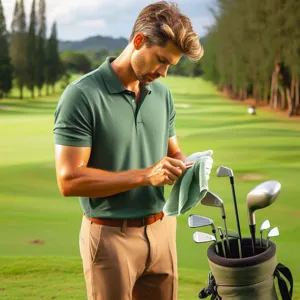Golf is a game of precision and finesse, and the tools you use can significantly impact your performance on the course.
Your golf clubs are not just equipment; they are extensions of your skill and craftsmanship, helping you navigate each hole with confidence. However, with the wear and tear of regular play, it’s crucial to prioritize their care and maintenance to ensure they remain in peak condition. In this blog post, we’ll delve into the essential tips and best practices for mastering golf club care. From cleaning and storage techniques to understanding when it’s time for a professional tune-up, these strategies will help you extend the lifespan of your clubs while enhancing their performance. Whether you’re a seasoned pro or a weekend warrior, investing a little time in proper club care can make all the difference in your game. Join us as we unlock the secrets to keeping your golf clubs in top shape, ensuring every swing is a step toward mastering the fairway.
1. Introduction to Golf Club Care

Golf clubs are more than just tools; they are an extension of a golfer’s skill and passion for the game. Proper care and maintenance of these essential instruments not only enhance their performance on the course but also ensure they have a long lifespan. Just like a musician cherishes their instrument, a golfer must treat their clubs with the same level of respect and attention.
In the world of golf, where precision and consistency are key, the condition of your equipment can significantly impact your performance. Dirt, debris, and moisture can accumulate on your clubs, leading to diminished accuracy and control. By adopting a routine care regimen, you can keep your clubs in peak condition, allowing you to play your best game every time you step onto the green.
This guide will delve into the fundamentals of golf club care, offering you essential tips and techniques for cleaning, storing, and maintaining your clubs. Whether you’re a seasoned pro or an enthusiastic beginner, understanding the importance of club care can elevate your game and enhance your overall experience on the course. Join us as we explore the best practices to ensure your clubs not only perform well but also stand the test of time, making every swing count.
2. Understanding Different Types of Golf Clubs
Understanding the different types of golf clubs is crucial for both novice and seasoned players, as each club is designed for specific situations on the course. Golf clubs can be broadly categorized into four main types: woods, irons, wedges, and putters, each serving a distinct purpose in your game.
Woods are typically used for long-distance shots, particularly off the tee or from the fairway. Their larger heads and longer shafts allow for greater speed and distance, making them ideal for reaching the green from afar. The most common wood is the driver, which boasts a deep face to help launch the ball high and far. When caring for your woods, ensure the heads are free from scratches and debris, as any imperfections can affect performance.
Irons, which range from 3 to 9, are the workhorses of the golf bag, used for a variety of shots throughout the course. They feature a flat clubface and shorter shafts, making them perfect for precision and control. Each iron is designed with a specific loft angle, allowing players to achieve different trajectories and distances. Regularly cleaning the grooves on your iron faces is essential to maintain spin and accuracy; dirt and grass can hinder performance dramatically.
Wedges, including pitching wedges, sand wedges, and lob wedges, are specialized irons designed for short approach shots, chips, and bunker play. Their unique lofts help players execute delicate shots around the greens. Pay particular attention to the condition of the clubface; a well-maintained wedge can significantly enhance your short game by providing better spin and control.
Lastly, putters are uniquely designed for the final strokes on the green. With a flat face and specialized weighting, putters allow for precise control over distance and direction. Since putting is often the most crucial aspect of a golfer’s score, keeping your putter clean and free of any obstruction is vital. Even the smallest dirt particles can impact the roll of the ball.
By understanding the characteristics and uses of each type of golf club, you can make informed decisions on when to use them and how to care for them properly. This knowledge not only enhances your performance on the course but also extends the lifespan of your equipment, ensuring that your clubs serve you well for many rounds to come.
3. Why Proper Care is Important for Performance

Maintaining your golf clubs is not just a matter of aesthetics; it’s a crucial component of performance that can significantly affect your game. Proper care ensures that each club functions at its best, allowing you to maximize your potential on the course. When clubs are well-maintained, they deliver more consistent results, helping to improve your accuracy and distance.
Clubs that are regularly cleaned and inspected are less likely to suffer from damage such as rust or bent shafts, which can compromise their performance. Dirt and debris can accumulate on clubfaces over time, altering the friction and spin characteristics essential for achieving the desired ball trajectory. For instance, a dirty wedge will not impart the same level of spin on the ball as a clean one, leading to subpar shots around the greens.
Additionally, proper care extends the life of your clubs, ultimately saving you money in the long run. Regularly checking grips for wear and tear enhances your grip on the club, ensuring better control during your swing. A worn grip can lead to slippage and inconsistency, hindering your performance.
Moreover, when you take the time to care for your clubs, you foster a sense of pride and connection with your equipment. This mental aspect cannot be underestimated in the game of golf, where confidence plays a pivotal role. By treating your clubs with respect, you not only enhance their performance but also contribute to a more enjoyable and successful golfing experience. Investing time and effort in proper care is an investment in your game.
4. Essential Tools for Club Maintenance
When it comes to maintaining your golf clubs, having the right tools on hand is crucial for ensuring their longevity and peak performance. A well-equipped maintenance kit not only extends the life of your clubs but also enhances your game by promoting consistent performance on the course. Here are some essential tools every golfer should consider:
1. **Club Cleaning Brush**: A specially designed cleaning brush with both nylon and wire bristles is a must-have. The nylon side is perfect for gently cleaning the faces of your irons and wedges, while the wire bristles can tackle the tougher grime on your woods. Regular cleaning removes dirt and debris that can affect ball contact and spin.
2. **Towel**: A microfiber towel is an excellent investment for keeping your clubs dry and free from moisture, especially when playing in wet conditions. Keep it clipped to your bag for easy access, and use it to wipe down your clubs after each shot to maintain their pristine condition.
3. **Groove Cleaner**: To ensure that your clubs perform at their best, a groove cleaner is indispensable. This small tool easily fits into the grooves of your clubface, removing dirt and grass that can hinder performance and affect your spin control. Regularly cleaning the grooves enhances ball grip and provides better control on the greens.
4. **Head Covers**: Protecting your investment is key, and head covers are essential for safeguarding your woods and putters from scratches and dings. Choose covers with a snug fit that can withstand the rigors of travel and storage, keeping your clubs looking and performing like new.
5. **Shaft and Grip Cleaner**: Over time, the grips on your clubs can accumulate oils and dirt from your hands, compromising your grip and swing. A grip cleaner and a simple damp cloth will help rejuvenate your grips. For the shafts, a gentle cleaner will remove any scuff marks or debris, ensuring a clean look and feel.
6. **Club Repair Kit**: If you’re serious about golf, a club repair kit can be a lifesaver. This kit should include tools for regripping, adjusting loft and lie angles, and removing or replacing club heads. Having these tools at your disposal can save you time and money, allowing you to maintain your clubs at home.
By investing in these essential tools, you’ll be well-equipped to keep your golf clubs in optimal condition. Regular maintenance not only protects your investment but also enhances your overall golfing experience, ensuring that you can focus on your game without the distraction of poorly cared-for equipment. Remember, a well-maintained set of clubs can make all the difference in your performance on the course!
5. Cleaning Your Clubs: Step-by-Step Guide

Cleaning your golf clubs is not just a matter of aesthetics; it’s crucial for maintaining performance and prolonging the life of your equipment. A thorough clean can help prevent dirt and debris from affecting your swing, ensuring that every shot is as effective as possible. Here’s a step-by-step guide to help you get your clubs looking and performing their best.
**Step 1: Gather Your Supplies**
Before you start, collect the necessary cleaning supplies. You’ll need a bucket of warm water, mild dish soap, a soft-bristle brush (an old toothbrush works well), a microfiber cloth, and a towel for drying. If you have them, club head covers can also be useful for protecting your clubs after cleaning.
**Step 2: Prepare the Cleaning Solution**
In your bucket, mix a small amount of mild dish soap with warm water. Avoid using harsh chemicals that could damage the finish of your clubs. The soap will help lift dirt and grime without harming the materials.
**Step 3: Soak the Clubs**
Carefully dip the clubheads into the soapy water. For clubs with particularly stubborn dirt, let them soak for a few minutes to loosen the debris. Be sure not to submerge the shafts or grips, as excessive moisture can weaken the adhesive holding the grip or cause damage to the shaft material.
**Step 4: Scrub the Clubheads**
Using the soft-bristle brush, gently scrub the clubheads to remove dirt, grass, and debris. Pay special attention to the grooves of the clubface, as they are essential for spin and control. Make sure to clean each club thoroughly, as neglecting one can affect your overall game.
**Step 5: Rinse and Dry**
Once you’ve scrubbed the clubheads, rinse them under clean water to remove any soap residue. After rinsing, use a microfiber cloth to dry each club completely, paying particular attention to the grooves. This step is vital to prevent water spots and corrosion.
**Step 6: Clean the Grips and Shafts**
Don’t forget about the grips! Wipe them down with a damp cloth and a mild soap solution to remove oils and sweat that can accumulate over time. For the shafts, a quick wipe with a dry towel will suffice.
**Step 7: Store Properly**
Once your clubs are clean and dry, store them in a cool, dry place. Consider using headcovers for woods and putters to protect them from scratches and dings. Proper storage will help maintain their condition and performance for years to come.
By following these simple steps, you can keep your golf clubs in optimal condition, ensuring they perform at their best when you need them most. Regular cleaning not only enhances your playing experience but also extends the lifespan of your equipment, making it a vital part of golf club care.
6. Inspecting Clubs for Damage and Wear
Inspecting your golf clubs for damage and wear is a critical step in maintaining their performance and ensuring they serve you well on the course. Regular checks can prevent small issues from escalating into larger, more costly problems—after all, a well-maintained club not only enhances your game but also extends its lifespan.
Start your inspection by examining the clubheads for any noticeable dents, scratches, or chips. These imperfections can affect the club’s ability to make solid contact with the ball, leading to inconsistent shots. For instance, a driver with a dented face may not deliver the same distance and accuracy you expect, while a chipped wedge can alter the spin and control of your short game.
Next, pay attention to the shafts. Look for signs of bending, cracking, or rust—each of which can significantly impact your swing dynamics. If you notice any irregularities, it’s wise to consult a professional or consider a replacement. Although it might be tempting to ignore minor bends, even slight imperfections can throw off your entire game.
Don’t forget about the grips, as they play a crucial role in your control during each swing. Check for wear and tear, such as slickness, cracking, or fraying. Grips should feel tacky and provide a comfortable hold; if they’re worn down, it’s time for a re-gripping. This simple yet effective maintenance task can drastically enhance your performance, providing the confidence you need to make those crucial shots.
Implementing a routine of inspecting your clubs after every few rounds will keep them in top shape. By staying vigilant for signs of damage and wear, you’re not just preserving your investment; you’re also ensuring that each time you step onto the course, your equipment is ready to help you achieve your best game. In the end, the care you provide your golf clubs reflects the dedication you have to your craft, and it can make all the difference in your performance on the green.
7. Tips for Proper Storage of Golf Clubs

Proper storage of your golf clubs is crucial for ensuring their longevity and consistent performance on the course. When clubs are stored correctly, they are protected from damage caused by environmental factors and everyday wear and tear. Here are some essential tips for keeping your clubs in top shape when they’re not in use.
First and foremost, consider the environment where you store your clubs. Ideally, they should be kept in a cool, dry place away from direct sunlight and extreme temperatures. Heat and humidity can warp shafts and deteriorate grips, while excessive cold can make metals brittle. A golf bag with a waterproof cover can be a great investment if you need to store your clubs outside or in an unheated garage.
When it comes to organization, always store your clubs in an upright position. This prevents the shafts from bending or getting damaged. If you’re using a golf bag, make sure the clubs are arranged neatly, with the longer clubs positioned on the side to minimize jostling. For added protection, consider using headcovers for your woods and putter. These protective covers shield the clubheads from scratches and dings, ensuring that they remain in pristine condition.
Regular cleaning before storage is also essential. Wipe down clubheads with a damp cloth to remove dirt and debris that can cause corrosion over time. Pay special attention to the grooves on the clubface, as any buildup can affect your ball’s spin and trajectory. After cleaning, dry the clubs thoroughly to prevent moisture buildup.
Finally, make a habit of checking your grips and shafts periodically. Look for signs of wear or damage, as catching these issues early can save you from costly repairs or replacements down the line. If you notice that the grips are losing their tackiness or the shafts show signs of rust, it might be time for a replacement.
By following these tips for proper storage, you’ll not only extend the life of your golf clubs but also ensure they perform at their best when you hit the course. Remember, well-cared-for clubs are the key to a great game!
8. The Importance of Grip Maintenance
When it comes to mastering golf club care, one of the most often overlooked yet crucial aspects is grip maintenance. The grip is your only direct connection to the club, making it an essential component for control and performance. A well-maintained grip not only enhances your feel for the club but also significantly affects your swing, accuracy, and overall enjoyment of the game.
Over time, grips can accumulate dirt, sweat, and oils from your hands, which can lead to a slick and uncomfortable surface. This not only compromises your hold but can also lead to mishits and a loss of power. Regular cleaning is key. Simply using warm, soapy water and a soft-bristled brush can work wonders. Be sure to rinse thoroughly and allow your grips to dry completely before use.
But cleaning is just part of the equation. Over time, grips wear out and lose their tackiness, leading to reduced performance on the course. It’s essential to monitor the condition of your grips and replace them when they start to feel hard or lose their texture. Most golfers should consider regripping their clubs at least once a year, but if you play frequently, you may need to do it more often.
Choosing the right grip is also vital. Preferences can vary based on factors like hand size, playing style, and weather conditions. Whether you prefer rubber, cord, or even hybrid grips, ensure that they suit your needs to maximize your performance.
In essence, proper grip maintenance is a small but mighty investment in your game. By keeping your grips clean and in good condition, you’re not just extending the life of your clubs; you’re also enhancing your ability to play your best golf. So, take a moment after each round to inspect your grips and give them the care they deserve—your swing will thank you for it!
9. When and How to Regrip Your Clubs
Regripping your golf clubs is an essential aspect of maintaining their performance and ensuring that you play your best on the course. Over time, the grips of your clubs can wear down, losing their texture and tackiness, which can lead to decreased control and accuracy during your swings. Understanding when to regrip your clubs and how to do it properly can make a significant difference in your game.
### When to Regrip Your Clubs
A good rule of thumb is to consider regripping your clubs once a year, but this can vary based on how often you play. If you’re an avid golfer who hits the links multiple times a week, you may find that your grips need replacing every six months. Signs that it’s time to regrip include:
– **Smoothness:** If the grip feels slick or slippery, it’s lost its texture and may not provide the necessary friction for a solid grip.
– **Cracks or Tears:** Inspect your grips for any visible damage, such as cracks, splits, or tears, which can compromise your grip and lead to inconsistent shots.
– **Discoloration:** Faded or discolored grips can indicate wear and may feel less comfortable in your hands.
– **Loss of Control:** If you find that your hands are slipping during swings or you’re not consistently hitting the ball as you used to, it might be time for new grips.
### How to Regrip Your Clubs
Regripping your clubs can be a straightforward process, and you have the option to do it yourself or take them to a professional. Here’s a step-by-step guide for those who wish to tackle it at home:
1. **Gather Your Materials:** You’ll need new grips, grip tape, a utility knife, solvent (like mineral spirits or grip solvent), and a clean working space.
2. **Remove Old Grips:** Use the utility knife to carefully cut away the old grip. Be cautious not to damage the shaft. Once the grip is removed, peel off any leftover grip tape.
3. **Prepare the Shaft:** Clean the shaft where the grip will go, ensuring it’s free of any debris or old tape residue.
4. **Apply Grip Tape:** wrap a new piece of grip tape around the shaft, overlapping slightly, and then remove the backing to expose the adhesive.
5. **Apply Solvent:** Generously apply grip solvent over the tape and the inside of the new grip. This makes it easier to slide the grip onto the shaft.
6. **Install the New Grip:** Align the grip with the shaft and slide it on while twisting it gently. Ensure it’s positioned correctly before the solvent dries.
7. **Let It Cure:** Allow the grips to dry completely, usually around 24 hours, before using the clubs. This ensures that the adhesive sets properly and provides a secure hold.
By keeping an eye on the condition of your grips and knowing when and how to regrip your clubs, you’ll not only enhance your performance on the course but also prolong the life of your equipment. Well-maintained grips contribute to a more enjoyable and successful golfing experience, ensuring that you’re always ready to make your best swing.
10. Keeping Clubheads in Top Condition
Keeping clubheads in top condition is essential for both the longevity of your golf clubs and the quality of your game. The clubhead is the part of the club that strikes the ball, and any damage or wear can significantly affect your performance on the course. Start by regularly inspecting your clubheads for signs of wear, such as dents, scratches, or rust. These imperfections can alter the club’s aerodynamics and impact the ball’s trajectory, so addressing them promptly is crucial.
Cleaning is a fundamental aspect of maintaining your clubheads. After each round, take a moment to wipe down the clubface and grooves with a damp cloth. This simple act removes dirt, grass, and debris that can accumulate during play and hinder your ability to achieve the desired spin and accuracy. For a deeper clean, consider using a soft-bristled brush and warm, soapy water to scrub the clubhead, especially in the grooves where dirt tends to gather. Rinse thoroughly and dry completely to prevent moisture from causing rust.
If you’re using forged or carbon steel clubs, be extra vigilant about rust prevention. These materials are more susceptible to corrosion, so applying a light coat of oil to the clubheads after cleaning can provide an extra layer of protection. Additionally, store your clubs in a cool, dry place, away from extreme temperatures and humidity, as these conditions can accelerate wear and tear.
Lastly, consider investing in headcovers for your woods and putters. These protective sleeves not only shield the clubheads from dings and scratches during transport but also help preserve the finish and overall integrity of your clubs. By taking these steps to keep your clubheads in top condition, you’ll not only extend the life of your equipment but also enhance your performance on the fairway, allowing you to focus on improving your game.
11. Regularly Checking Loft and Lie Angles
Regularly checking the loft and lie angles of your golf clubs is a crucial step in maintaining their performance and ensuring that you’re getting the most out of your game. These angles can significantly influence how the ball flies off the clubface and can affect your accuracy and distance. Over time, even slight alterations in these angles can occur due to regular use, particularly if you tend to hit the ground hard or if your clubs have been subjected to rough handling.
To begin with, understanding the basics of loft and lie is essential. Loft refers to the angle of the clubface relative to the ground, influencing the trajectory and spin of the ball. Lie angle, on the other hand, is the angle between the shaft and the ground when the club is in its address position. A proper lie angle ensures that the sole of the club sits flat on the ground at impact, which is key to achieving consistent shots.
To check these angles, you can either invest in a fitting session at your local pro shop or utilize a loft and lie machine if you have access to one. Many golf shops offer this service, often with professional club fitters who can provide insights and adjustments tailored to your swing style and body mechanics. If you notice your shots veering left or right, it might be time to assess whether your lie angle needs adjustment.
Additionally, routine checks—ideally every season or after significant play—can help maintain optimal performance. Keeping an eye on these angles not only extends the life of your clubs but also enhances your overall gameplay, allowing you to hit more accurate shots and achieve better results on the course. By prioritizing loft and lie checks as part of your club care routine, you set yourself up for a more enjoyable and successful golfing experience.
12. The Role of Shaft Care in Performance
When it comes to golf clubs, the shaft often takes a backseat in discussions about performance and maintenance. However, the truth is that the shaft plays a pivotal role in how your club performs on the course. Neglecting its care can lead to diminished performance, so understanding how to maintain your shafts is crucial for any golfer looking to enhance their game.
First and foremost, it’s essential to recognize that shafts are subjected to a considerable amount of stress during play. Every swing, every impact with the ball can lead to micro-damage that, over time, can affect the shaft’s flexibility and strength. To avert this, begin by regularly inspecting your shafts for any signs of wear, such as dents, scratches, or bends. If you notice any irregularities, it may be time to consider a replacement or a professional assessment.
Cleaning your shafts is another vital aspect of care. Dirt, grime, and sweat can accumulate over time, particularly if you play in inclement weather or on dusty courses. Use a soft cloth and a mild cleaning solution to wipe down the shafts after each round. This simple act not only keeps your clubs looking sharp but also prevents corrosion, especially on steel shafts. Remember to pay special attention to the ferrule—the small collar where the shaft meets the clubhead—keeping it free from dirt and moisture to prevent any potential loosening.
Additionally, consider the impact of temperature and humidity on your shafts. Extreme conditions can affect the material properties of both graphite and steel shafts. When storing your clubs, ensure they are kept in a climate-controlled environment, away from the extreme heat of a car trunk or the dampness of a garage. This will help maintain the integrity of the shaft and ensure that it performs optimally every time you hit the course.
Finally, remember that the relationship between the shaft and your swing is a delicate one. If you experience changes in your performance or feel discomfort while playing, it may be worth consulting with a professional club fitter. They can assess whether your current shafts are the right fit for your unique swing style and physical attributes, ensuring that every swing is as effective as possible.
By prioritizing shaft care, you’re not just prolonging the life of your clubs; you’re also investing in your game. A well-maintained shaft can lead to improved accuracy and distance, allowing you to play at your best. So, take the time to nurture this often-overlooked component, and watch as your performance on the green flourishes.
13. Seasonal Care: Preparing Clubs for Off-Season
As the golf season winds down and the chill of winter sets in, it’s essential to shift your focus from swinging on the green to ensuring your clubs are ready for a prolonged hiatus. Proper seasonal care not only helps maintain the performance of your clubs but also extends their lifespan, saving you both time and money in the long run.
Start by giving your clubs a thorough cleaning. Remove any dirt, grass, and debris that may have accumulated during your rounds. A gentle scrub with warm, soapy water and a soft brush will help dislodge stubborn grime, particularly from the grooves of your irons and wedges, which can affect your shot accuracy. Rinse them well and dry them with a soft cloth to prevent moisture from causing rust.
Next, inspect your grips carefully. Worn or damaged grips can significantly impact your control and accuracy. If you notice signs of wear, consider replacing them before storing your clubs away. This investment will ensure that your clubs are ready for action as soon as the season picks back up.
Once your clubs are clean and in good condition, it’s time to protect them from the elements. Invest in headcovers for your woods and putter to prevent dings and scratches while they’re in storage. Additionally, if you’re storing your clubs in a damp area, consider using silica gel packs to absorb moisture and keep your clubs dry.
Lastly, find a suitable storage location. A climate-controlled environment is ideal. Extreme temperatures and humidity can warp club shafts and damage the integrity of the grips. If you can’t store them indoors, a dedicated golf bag in a dry, cool place will suffice, but be sure to check in periodically to ensure everything is in good condition.
By taking these simple but effective steps to care for your clubs during the off-season, you’ll ensure they remain in peak condition, ready to deliver optimal performance when you return to the course. Embrace this downtime as an opportunity to invest in the longevity of your gear, and you’ll reap the benefits when the first tee time of the next season arrives.
14. Common Mistakes to Avoid in Club Care
When it comes to maintaining the longevity and performance of your golf clubs, avoiding common mistakes can make all the difference. Many players, whether seasoned golfers or newcomers to the game, often overlook the importance of proper club care, leading to premature wear and tear. Here are some key pitfalls to steer clear of:
**Neglecting Regular Cleaning:** One of the biggest mistakes is failing to clean your clubs after every round. Dirt, grass, and debris can accumulate on the clubface and grooves, affecting your swing and shot accuracy. Make it a habit to wipe down your clubs with a damp cloth or use a soft-bristle brush to remove any buildup. A clean clubface ensures optimal contact with the ball, enhancing your performance on the course.
**Storing Clubs Improperly:** Another common oversight is improper storage. Many golfers toss their clubs into a corner of the garage or leave them in the trunk of their car, exposing them to temperature extremes and moisture. Instead, store your clubs in a climate-controlled environment, ideally in a dedicated golf bag or rack that shields them from dust and potential damage.
**Ignoring Grip Maintenance:** Your grips are your only connection to the club, yet they are often the most neglected component. Worn-out or slick grips can lead to inconsistent swings and decreased control. Regularly inspect your grips for signs of wear, and clean them with a mild soap solution to maintain their tackiness. Consider re-gripping your clubs periodically, especially if you play frequently or notice a change in feel.
**Using the Wrong Tools for Cleaning:** It’s tempting to grab any cloth or scrub brush lying around, but using inappropriate cleaning tools can scratch or damage your clubs. Stick to microfiber cloths for wiping down surfaces and soft brushes specifically designed for golf clubs. Investing in proper cleaning tools not only protects your clubs but also helps maintain their aesthetics.
**Failing to Check for Damage:** Many golfers play on without realizing their clubs have sustained damage. Regularly inspect your clubs for dents, dings, or loose heads. Addressing these issues promptly can save you from costly repairs or replacements down the line.
By steering clear of these common mistakes, you’ll ensure that your golf clubs remain in prime condition, ultimately enhancing your game and extending the lifespan of your equipment. Prioritizing proper care will not only improve your performance but also instill a sense of pride in your golf gear, making every swing a joy to execute.
15. Conclusion: Investing in Your Equipment for Better Golfing Experience
When it comes to enhancing your golfing experience, the importance of investing in the care and maintenance of your golf clubs cannot be overstated. Just as a well-tuned engine drives a car smoothly down the highway, properly maintained clubs can significantly improve your performance on the course. While purchasing high-quality equipment is an essential first step, the true magic lies in how you care for it.
By regularly cleaning, inspecting, and protecting your clubs, you not only prolong their lifespan but also ensure they perform at their best when you need them most. A clean clubface allows for better ball contact and spin, while a well-maintained grip provides the traction you need to execute powerful swings. Moreover, investing in the right storage solutions and protective gear means your clubs are shielded from the elements and unnecessary wear and tear.
Remember, your golf clubs are not just tools; they are an extension of your game. Treat them with the respect they deserve, and they will reward you with improved performance and consistency. Whether you’re a seasoned player or a weekend warrior, taking the time to invest in your equipment paves the way for countless rounds of enjoyable golf and improved scores. After all, a well-cared-for set of clubs is a testament to your commitment not only to the sport but also to your own enjoyment and success on the course. Embrace the practice of club care, and watch as it transforms your golfing journey into an even more rewarding experience.
In conclusion, mastering golf club care is not just about maintaining your equipment; it’s about enhancing your overall game and ensuring that each swing is as effective as possible. By following the essential tips outlined in this post, you can significantly extend the longevity of your clubs while also optimizing their performance on the course. From proper cleaning techniques to thoughtful storage solutions, these practices will help you preserve your investment and enjoy a more rewarding golfing experience. So, take the time to implement these tips, and watch as your clubs work in harmony with your skills, allowing you to play your best round yet. Happy golfing, and may your clubs always be in peak condition!






